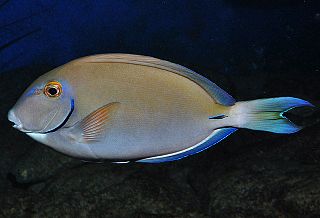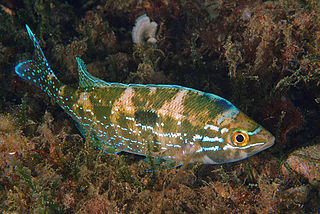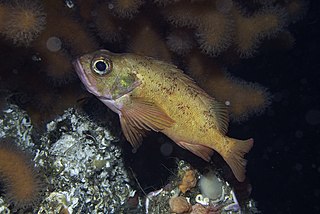
The orbicular batfish, also known as the cooper batfish, circular batfish, orbiculate batfish, round batfish, narrow-banded batfish or orbic batfish is a species of marine ray-finned fish belonging to the family Ephippidae, the spadefishes and batfishes. This species is found in the Indo-Pacific but has been recorded outside its native range in the western Atlantic Ocean.

Caproidae, or boarfishes, are a small family of marine fishes comprising two genera and 19 species. These fishes are found throughout the world in temperate and tropical seas.

Antigonia is a genus of marine ray-finned fish belonging to the family Caproidae, the boarfishes. This genus is found in the warmer oceans around the world and is the only extant genus in the subfamily Antigoniinae.

Pagrus is a genus of marine ray-finned fishes belonging to the family Sparidae, which includes the seabreams and porgies. These fishes are found in the Western Pacific Ocean, Atlantic Ocean and Mediterranean Sea. They are esteemed food fishes which are targeted by commercial fisheries and are grown in aquaculture.

Scatophagus argus, the spotted scat, butterfish, mia mia, spotted butterfish or tiger scat, is a species of fish in the scat family Scatophagidae. It occurs in two basic color morphs which are called green scat and ruby or red scat. This fish is generally distributed around the Indo-Pacific region, to Japan, New Guinea, and southeastern Australia. They live in coastal muddy areas, including estuaries, mangroves, harbours, and the lower courses of rivers. They are popular aquarium fish.

Acanthurus nigricans, the goldrim surgeonfish, velvet surgeon, whitecheek surgeonfish, yellow-banded surgeonfish or yellowrimmed surgeonfish, is a species of marine ray-finned fish belonging to the family Acanthuridae, the surgeonfishes, unicornfishes and tangs. This species is found from the central Indo-Pacific area to the eastern Pacific coast, Hawaii included.

The deepbody boarfish, or robust deepsea boarfish, is a species of marine ray-finned fish belonging to the family Caproidae, the boarfishes. This fish is found in the warmer waters of the Atlantic, Indian and Pacific Oceans.

The piper gurnard, also known as the piper or the lyre gurnard, is a species of marine, demersal ray-finned fish from the family Triglidae, the gurnards and sea robins. It is found in the eastern Atlantic Ocean and the Mediterranean Sea. It is the only species in the monotypic genus Trigla.

The streaked spinefoot, also known as the Java rabbitfish, blue-spotted spinefoot, blue-spotted trevally, Java spinefoot or white-spotted rabbit-fish, is a species of marine ray-finned fish, a rabbitfish belonging to the family Siganidae. It is found throughout most of the Indo-Pacific region.

Acanthurus tractus, the five-band surgeonfish, ocean surgeon, or ocean surgeonfish, is a species of ray-finned fish in the family Acanthuridae found in the western Atlantic Ocean, Florida, the Bahamas, the Caribbean Sea and the Gulf of Mexico. Until recently, it was considered a synonym of Acanthurus bahianus, but its status as a separate species was resurrected in 2011.

The black scorpionfish, also known as the European scorpionfish or small-scaled scorpionfish, is a venomous scorpionfish, common in marine subtropical waters. It is widespread in the Eastern Atlantic Ocean from the British Isles to the Azores and Canary Islands, near the coasts of Morocco, in the Mediterranean Sea and the Black Sea.

The red gurnard, also known as the East Atlantic red gurnard or soldier, is a benthic species of ray-finned fish belonging to the family Triglidae, the gurnards and sea robins. This fish is found in the eastern Atlantic Ocean, including the Mediterranean Sea and the Black Sea.

The bigeye grunt is a species of marine ray-finned fish, a grunt belonging to the family Haemulidae. It is native to the Atlantic coast of Africa.

Diplodus vulgaris, the common two-banded sea bream, is a species of marine ray-finned fish belonging to the family Sparidae, which includes the seabreams and porgies. This species is found in the northeastern Atlantic Ocean and the Mediterranean. It is an important species for fisheries and is grown in aquaculture.

Spicara maena, the blotched picarel, is a species of ray-finned fish native to the eastern Atlantic Ocean, the Mediterranean Sea and the Black Sea. The male grows to a maximum length of about 25 cm (10 in), and the female reaches 21 cm (8 in). This fish is fished commercially in some areas.
Gerres nigri, the Guinean striped mojarra is a species of mojarra native to the eastern Atlantic Ocean. It inhabits estuaries, coastal waters and lagoons. This species can reach a maximum length of 20 cm (8 in), with 15 cm (6 in) being a more common size.

Sebastes viviparus, the Norway redfish, small redfish, lesser redfish, ocean perch or rosefish, is a species of marine ray-finned fish belonging to the subfamily Sebastinae, the rockfishes, part of the family Scorpaenidae. It is found in the northern Atlantic Ocean.

Siganus spinus, the little spinefoot, scribbled rabbitfish, blunt-nosed spinefoot, spiny rabbitfish, or spiny spinefoot, is a species of marine ray-finned fish, a rabbitfish belonging to the family Siganidae. It is found in the Indo-Pacific region.

Antigonia rubescens, the Indo-Pacific boarfish or sharpsnout deepsea boarfish, is a species of marine ray-finned fish belonging to the family Caproidae, the boarfishes. This fish is found in the Indo-West Pacific region.

Antigoniinae is a subfamily of marine ray-finned fishes belonging to the family Caproidae, the boarfishes. These fishes are found in the warmer oceans throughout the world.



















